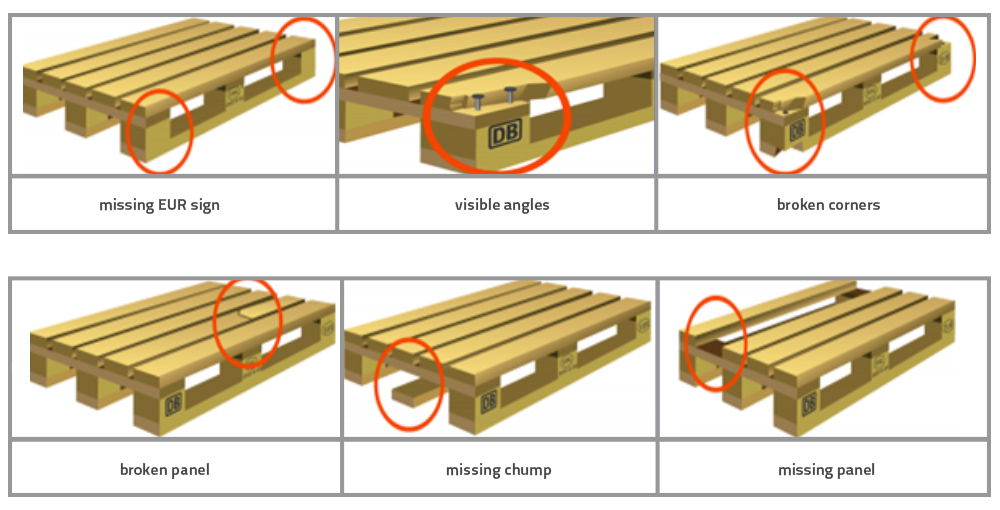
logistic standards
Basic pallet conditions
- Pallets must be clean.
- Not allowed oil, paint or any contamination incompatible with foods.
- Pallets can not be punked, freaked or fungal infected.
- Incomplete decking is not allowed.
- Replacement of the decking parts It is not allowed.
- Nails, or metal parts are not allowed.
- It can not be considered exchange pallet if it has no EUR/MÁV sign.
- Defected pallets or damaged billets are not allowed.
- At loading the driver checks the pallets and confirms with his signature on the CMR, that the goods were taken over on paletts in accordance with quality standards.
- At handover of the goods the driver is responsible for the qualitative take over of the exchange pallets in accordance with the above. In case of any difference, it must be noted in the heading no. 18 of the CMR.
EUR pallets quality standards
Pallets by acceptable quality

Pallets not able to exchange

General fault / photo is illustration/

Loading of the H1 plastic pallets
Suggestions:
- It is recommended to clean the pallets with high pressure water before using it. The pallet is delivered directly to the processing plant with the goods, so its cleanliness is important.
- The H1 plastic pallet cannot be slide on the ground or on the platform!
- It is not possible to lift with a “half fork”, the pallet must be lifted in full cross-section!
- The plastic pallet cannot be set on the platform with the tip of the fork!
Loading suggestions:
The pallet should be placed on the platform of the truck with a full fork and set in place with a handlifter.
We recommend loading from the back of the platform.
When the pallet is returned, the integrity of the pallet must be checked, any cracks and breaks must be recorded, and in case of damage, a report must be made.
Guideline for loading of 20 feet containers
Steps:
1. Identification
Checking of the container and seal numbers, if correspond to the forecast details given by Winter Trade Zrt.
2. Checking the condition of the container:
2a.: Dark test
Inspection of the container inside, at the door of a closed container, is there any visible infiltrating light.
2b.: Water test
Checking the rubber seals at the container door, wheather the container closes properly.
Sprinkling the conatiner door along the rubber insulation with bucket or hose, outside from above, while checking from inside whether moisture is entering. Loading must be rejected if even the slightest amount of moisture gets inside the container.
2c.: Checking the cleanliness of the loading area of the container.
Make sure there is not any dirt or contamination that could endanger the proper condition of the loaded goods.
2d.: Checking the floor, side walls and ceiling of the container.
Is there any overhang, dent, or welded pieces inside which reduce the internal volume of the container to such an extent that the quantity of the goods does not fit or endangers the safety of the goods during loading or transport.
3. The goods should be stacked as far as possible in a bond, furthermore corrugated paper should be placed between the goods and the floor, and sidewall of the conatiner.
4. The packages should be placed closed side by side. We insulate the gap between the goods and the door with nikecell, not with corrugated paper or scrap cardboxes. It is important that when the container is moved longitudinally, the goods cannot move, thus after closing of the door should stay max 1 centimeter air gap to prevent the tighten of the seal.
5. We always ask for taking photos of the loading, both about the container and way of of stacking. So in the event of damage we can prove to the insurer company the correct method of loading.
Photos are requested as below:
– before loading the inside of the empty container and the walls
– during loading when the container is half loaded
– when the full quantity has been loaded, before the door is closed, it can be seen that any gap has been filled with nikecell
– about the locked container
1. the container sela number legible
2. container identification number and tare weight
The seal nr. should be entered in point 17 of the CMR.
The photos should send by email to WinterTrade.
If there is even the slightest problem during container inspection or loading, must stop immediately and contact WinterTrade by email and phone, loading cannot be continued until further instruction.